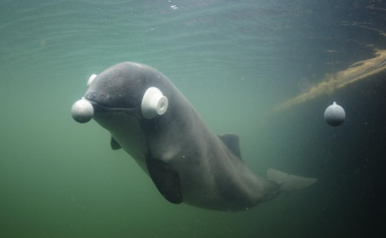Task performance and target discrimination
The dolphin’s ability to discriminate between objects, in this case hollow cylinders, is associated with their ability to perceive temporal and frequency cues in the echo spectra.
When detecting targets, dolphins dynamically change the characteristics of their clicks and the trajectory of their sonar beam to get more precise information.
Wisniewska et al. (2012) did a discrimination task with free swimming porpoises and saw that the animals adjusted beam direction and range-dependent parameters in their clicks during the whole approach to the targets.

How being able to swim freely could have helped?
Different studies show that biosonar adjustments happen all the time during target selection and approach. This allows free-swimming animals to have a greater degree of control over their perception and how their perceive their surroundings, potentially allowing them to detect more subtle differences in the echo spectra and therefore make more fine discriminations.
Scanning behavior and attention
What can we observe in Aquille’s scanning behavior?
Decline between the cylinders that differed by 0.6 mm to the ones that differed by 0.3 mm
This could be attributed to a learning curve, where the animal needed more information in the first trials since it was a new task, but in the next ones it is possible that the animals became familiar with the spectral cues that distinguish the cylinders and could solve the task more easily.
Increase in the cylinders that differed by 0.3 mm to the ones that differed by 0.05 mm
This shows a possible trend where dolphins may increase the number of head scans as the task becomes more difficult to reflect an increase in the animal’s attention. In difficult trials, the animal may have needed to gather more detailed acoustic information to make a decision. Increasing the number of scans allows the dolphin to sample their surroundings from slightly different angles, potentially enhancing the contrast between subtle spectral features.
This behavior mirrors what has been observed in bats, which increase the complexity and frequency of their scanning patterns when navigating cluttered or uncertain environments
Performance asymmetry between thicker and thinner comparison cylinders
In contrast to our own observations, the dolphin in the Au and Pawloski (1992) experiment performed better when the comparison cylinders were thinner, presenting also a smaller discrimination threshold for the thinner comparison cylinders. This suggests that the dolphin had more ability to discriminate the cylinder with thinner wall thickness compared to the standard one.
In the present study the animals performed better in the thicker comparison cylinders. Furthermore, if we look at the discrimination threshold, we found some significant results for the thicker comparison cylinders in the 0.05 mm and 0.1 mm thickness difference, but none of the animals were able to discriminate above chance level when the comparison cylinder differed by the same thickness but being thinner.
This contradiction could be explained by external factors affecting the animals during the trials or individual differences since the studies were performed with a small pool of animals.